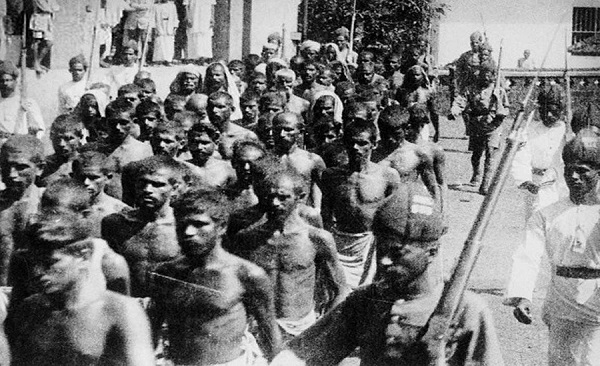
Kerala is one state where the public health services are more organised and accessible to most people. It is also the state where the forces representing nationalism in the name of religion have not been able to get the electoral success in substantial way. This despite large network of RSS Shakhas and their consistent efforts to communalise issue like Sabrimala women’s entry issue. There is a running battle of physical violence between the cadres of RSS and CPM in Kannur. Both blaming the other and presenting the figures where those killed due to this violence are shown to be larger on their side.
To add to the opportunities of polarising the society, the forthcoming centenary of the Malabar rebellion also called Mappila rebellion in 2021 may provide another occasion to the communal forces. Recently a film director Aashiq Abu declared a film project Variyamkunnan on the life of Variyamkunnath Kunhamded Haji, a leader of the rebellion, who was executed by the British. His struggle was mainly around the issues of peasantry, who were suffering severe oppression at the hands of the landlords and their minions. These landlords, Janmis, mostly upper caste Hindus, were well protected by the British. Interestingly the problem arose as the landlords were Hindus and the peasants were Muslims.
As we know Islam first came to India on the Malabar Coast through Arab traders and many of those who were victims of caste, Varna system took to Islam due to this interaction. As a symbol of this initial entry of Islam in India, we cherish the Cheraman Juma mosque, the first one in India, being located in Malabar region.
As the film project was announced, it seemed another opportunity for communal elements to polarise the society along the lines of religion. One Hindu Aikya Vedi came forward with a programme of campaign to oppose the film makers’ goal to ‘glorify’ Haji along with other leaders who were at the forefront of the Mappila rebellion, also referred to as Moplah uprising. This rebellion had broken out in August 1921 in Southern region of Malabar and Haji was captured in January 1922.
The rebellion failed and was ruthlessly suppressed by the British. There crept in Muslims versus Hindu angle though the main leadership of the rebellion kept it as a rebellion to address agrarian grievances. Few marginal elements did make it anti Hindu tirade. As per Arya Samaj (Quoted in Sumit Sarkar’s book on Modern India) nearly 2500 Hindus were converted and 600 of them were killed.
The rebellion occurred at a time when the movement for restoration of Khilafat in Turkey was on. In India under the leadership of Gandhi, Indian National Congress supported the Khilafat movement, the primary aim of Gandhi led Congress being to ensure that Muslims also become part of the anti-British movement. During the rebellion, Haji led many attacks on individuals, including against Muslims, who had been loyal to the British.
This rebellion also gave the opportunity to some rabid fundamentalist elements who presented the rebellion to look as against Hindus. As such in the rebellion many non Muslims also participated and many Muslims did not support the anti Hindu stance of those elements.
As such the deeper issue of the rebellion was the severe oppression of the poor peasants. The rebellion of peasantry had a long history in the area prior to 1921. As the Janmi landlords, backed by the police, the law courts and the revenue officials; became more oppressive on the subordinate classes, the Moplah peasantry in its turn started to revolt against them. There were series of these uprisings first such outbreak took place in 1836 and later between 1836 and 1854, 22 similar uprisings occurred, of which the one of 1841 and 1849 were very serious.
Sociologist D N Dhanagare’s summary of the rebellion is very apt. As per him it was due to, “gross neglect of the basic tenurial security, the deterioration of landlord-tenant relations and the political alienation of the poor peasantry were the important formative conditions” of the rebellion. He further observes that the basic movement around tenancy issues got intermixed with the Khilafat movement and non cooperation movement.
The Khilafat movement launched in 1919 was instrumental in providing a new stimulus to the grievances of Muslim peasants. As Khilafat Movement created pan Islamic sentiments, the local grievances got linked up with the global one’s, giving it a new vigor. Later the collapse of Khilafat gave a feeling of utter frustration and intensification of violence.
In this complex scenario, the Haji, on whom the film is being planned, was firmly against giving a religious colour to the rebellion, while a small section tried to give it a communal turn, mainly due to the fact the Janmis (Landlords) against whom the rebellion was directed were primarily Hindu, upper caste. British rule was great protector of atrocities and severe exploitation by the landlords. Haji during the rebellion, led many attacks on individuals, including against Muslims, who had been loyal to the British.
The Malabar rebellion to an extent did create the intercommunity strife, which was unintended and nowhere on the agenda of leaders of rebellion like Haji, on whom the film has been planned. British, who were looking at furthering their ‘divide and rule’ policy through every mechanism, did present it as being an attack by Muslims against Hindus.
The Hindu communal forces have been presenting it as genocide of Hindus. Rebellion was suppressed ruthlessly by British with nearly 10000 Muslims killed and a larger number exiled to Andmans. A rebellion which was primarily a peasant rebellion unfortunately got mired by complex situation. A proper evaluation of the rebellion will help us see the totality of the societal phenomenon in a better light.








